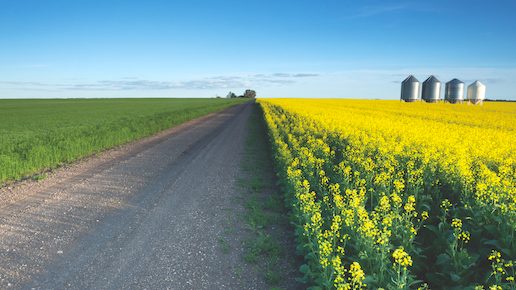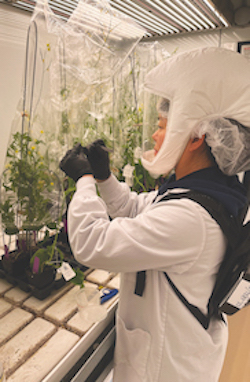
By Jennifer Barber
Believe it or not, what ends up as about 4.25 million seeds in a bag of DEKALB, started out about three years earlier as a few grams of breeder seed in a small envelope. How that tiny amount of seed scales up to commercial quantities involves precision, careful controls and well-planned processes that maintain breeding integrity every step of the way.
“Plant breeding has now caught up to where animal breeding has been for a while,” says Dale Burns, product development breeder, canola, with Bayer. “With our current knowledge of genetics everything is less a breeder guess and more planned out. We are able to use genomics to know what outcomes are likely and this has cut down the breeding process by a few years. Everything about plant breeding is about how big the numbers are, how reliable the traits are and how fast we can get those genetic gains into a new product.”
Getting from that initial envelope of breeder seed to a bag of hybrid canola takes about three years and involves three main steps: breeding quality genetics, producing parental lines and commercialization of each hybrid seed.
STEP 1: Breeding quality genetics

When developing new hybrids, Bayer’s efforts are aimed at varietal purity. In the lab, workers are geared up to avoid any contamination.
“Even before our development team starts looking at new genetics, there are teams of design scientists who are using new technologies to sift through genomic data and predict the best parents for new hybrids,” says Burns. “They are using modelling and knowledge of genetics to predict what parental lines will have the best yield and other desirable traits.”
When the parental lines come to the development breeding team, they are run through a variety of predictive tools to virtually create an initial 10,000 possible hybrids. The team then narrows that down to around 1,000 new hybrids, which may ultimately go on to be produced in Chile and put into field trials across the Prairies. The team is looking for stable options that are consistent across different environments.
“We throw away probably 90 per cent of the options we come up with,” says Burns. “We then trial (the remainder) under the toughest conditions to find exactly what we are looking for — always high yielding, but also disease resistant with good maturity, lodging and traits like our new pod shatter. We have already predicted how it will perform, then we put it out in the field and prove it.”
At this point everything is bred using conventional herbicide technology. Simultaneous to the efforts already described, Bayer’s trait integration scientists take the new parental inbred lines and add herbicide tolerant (HT) traits. This is a backcrossing process and is done so fast that HT versions of potential lines are ready after the first year of hybrid testing, which kicks off the two-year testing process required for registration.
“At this point we will have a few grams of very pure seed,” says Burns. “This will be the gold standard of that particular line. It is exactly what we have designed it to be when we send it to Cranbrook, BC for the next cycle. We have incredibly tight controls, with separate machines for each technology so that there is no risk for contamination.”
Burns and his team send 30 to 50 coin-sized envelopes of breeder seed to Cranbrook each year. The number varies each year depending on the traits that are being developed and the number of field trials planned. “All our efforts are aimed at varietal purity, and everything we do is to maintain that purity,” says Burns. “We have high confidence in the quality genetics we are able to hand off.”
STEP 2: Producing parental lines

A Hagie high-clearance sprayer with a customized header trims female plants at the commercial production and breeding site in Lethbridge, AB (top). Bayer contracts local honeybee and leafcutter beekeepers to pollinate the crop (centre). Parental lines are produced at Bayer’s canola seed production site in Cranbrook, BC. Pictured (bottom) is foundation seed in rosette stage with pre-foundation seed tents in the background.
From that small packet of breeder seed, the next step is to scale up volume for the parental lines, which are male and female lines that will make the final hybrid.
This is done at Bayer facilities in Cranbrook, BC, during our Canadian summers, or at Bayer facilities in Chile during Canadian winters. “Our job is to make more of the parental lines, and to maintain their purity over two generations of growth,” says Joerg Lehmann, site lead at the canola seed production site in Cranbrook. “Each generation roughly multiplies the seed by 1,000. We always have a crop in the ground somewhere, and we are continually testing and roguing the fields to maintain purity throughout the process.”
Bayer recently upgraded the canola seed production site in Cranbrook where the pre-foundation seed, foundation seed and experimental plot seed operations are managed, considerably increasing the site’s capacity since starting production in the area in 1996. Virtually all canola parent seed grown for Bayer and its seed partners originates from this production site.
First, they take those 30 to 50 seed selections handed off from the breeding program, which at this point are only a couple of grams each, and grow them inside 10 x 20 metre tents in isolated fields. This is a protected, heavily controlled and managed environment designed to multiply those few grams into a few kilograms of pre-foundation seed. The tents are covered with a mesh material to restrict pollen movement. The work is highly manual, done with hand tools, and requires high levels of intensive management.

“All our efforts are aimed at varietal purity, and everything we do is to maintain that purity. We have high confidence in the quality genetics we are able to hand off”
DALE BURNS PRODUCT DEVELOPMENT BREEDER, CANOLA BAYER
In the next stage, pre-foundation seed is multiplied up to create foundation seed. It is grown in small plots of about two to six acres in the mountainous areas of Cranbrook or Chile. These areas were chosen because they are not typical canola growing regions, and the hills and mountains create a natural isolation barrier for each crop. Each field is anywhere from five to 10 kilometres apart and is on a seven-year rotation.
“We are able at this stage to use actual farm equipment, but it is highly modified,” says Lehmann. “When you picture how small a canola seed is, we have to make sure we get every seed of canola out of every piece of equipment to guarantee purity. These small fields don’t take a long time to seed or to harvest, but it takes a large crew and a lot of hours to clean the equipment to maintain purity.”
Quality management is key at this stage to make sure the increase in seed volume maintains the breeder’s vision for an inbred. From a couple of hundred pre-foundation varieties each year, the team generally ends up with around 35 to 40 different inbred parental lines at the foundation seed level.
STEP 3: Taking a hybrid to commercialization
Each female and male line of foundation seed is then shipped to Bayer’s site in Lethbridge, AB. There, the parental lines are cleaned, treated and packaged, ready for seeding on contracted fields with seed growers. The goal is to produce multiple hybrids to meet customer demand each season.
“We contract with local growers to grow on 130-acre irrigated pivot circles,” says Robert Wauters, site lead at the Bayer’s commercial production and breeding site in Lethbridge. This is not traditionally a large canola growing region, so the team is able to geographically isolate new hyrbids from other canola fields to maintain purity. By using contract growers under irrigation, they are also able to mitigate some of the weather risk of growing canola, in an area with a long growing season.
“Each field is row cropped with four rows of female seed, and one row of male seed alternating across the width of the field,” says Wauters. “We contract with local honeybee and leafcutter beekeepers to pollinate the crop. We also use specialized high clearance field equipment to trim the parent lines to keep the flowers in the male and female lines synchronized.”
He explains that they use the same machinery with a different header to specifically cut the male rows out of the field as this is not seed they want — hybrid seed is produced by the sterile female lines that have been crossed with pollen from the male lines.

“We contract with local honeybee and leafcutter beekeepers to pollinate the crop. We also use specialized high clearance field equipment to trim the parent lines to keep the flowers in the male and female lines synchronized”
ROBERT WAUTERS SITE LEAD BAYER’S COMMERCIAL PRODUCTION AND BREEDING SITE, LETHBRIDGE
When those plants produce pods, they are swathed and combined using normal farming methods. During the winter months, the Lethbridge crew run the harvested seed through their onsite commercial cleaning plant, then send it out to be treated and bagged at third party contract facilities.
“Each contract field will yield more than 100 metric tonnes of canola seed,” says Wauters. “Part of the magic of hybrid canola is its incredible ability to multiply. In a span of just a few years you can go from just a coin envelope of breeder’s seed to over 100 metric tonnes of hybrid canola that meets the agronomic and trait specifications of the hybrid first created by the breeder.”
“We are continually pushing to grow the highest yielding, highest quality commercial canola hybrids each season,” says Wauters. “This year we will be producing at least 12 canola hybrids. With more agronomic traits attached to a variety of herbicide tolerance systems, we are continually working to meet the demands of our canola seed customers.”